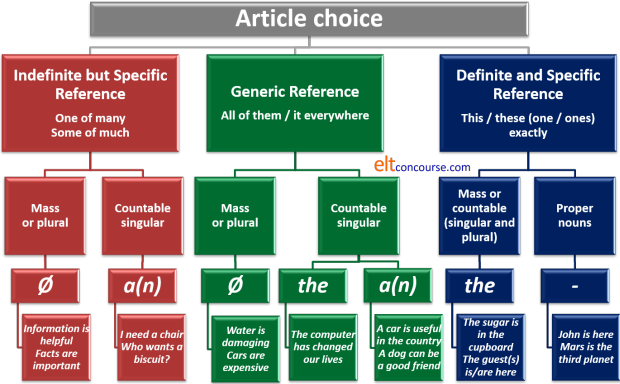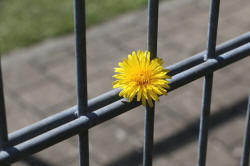The essential guide to the article system

Articles in English form a sub-class of determiners. If you want the overview first, therefore, you should look at the essential guide to determiners (new tab).
This guide covers the essentials only (there is a link to a more
comprehensive one in the in-service section in the list of related
guides at the end) and focuses only on English which happens to have
a reasonably well-developed article system.
However, at the outset, you should be aware of the fact that
languages differ:
- Slavic languages (Russian, Polish, Bosnian, Czech etc.) as well as Chinese languages, Indonesian, Japanese, Hindi and Urdu do not have an article system.
- Turkish, Persian languages and Arabic (which often encodes the definite article as a prefix) have no indefinite article.
- Many other European languages have an article system but the rules are different and may be transferred into English by learners.
- A wide range and large number of languages have gender systems of some sort and the gender of a noun is often recognisable by the form of the article its takes. English does not do this but shows other characteristics of a noun by the article choice.
 |
What are articles? |
English has three sorts of articles. Here are six examples, showing two incidents of each of the English articles.
- That's an interesting idea
- He went to the museum
- Do not wash in hot water
- Give me a piece of that
- The Ambassador is coming
- Houses are expensive here
 |
or |
 |
Can you identify
the sort of article used in those sentences? Click when you've done that. |
- The indefinite article occurs in:
Sentence 1.: That's an interesting idea
and
Sentence 4. Give me a piece of that
In English this is either a or an but some will include some as a plural indefinite article.
The article an occurs slightly irregularly.
The general rule is that we use an before a vowel sound, but we use a before a consonant sound and in both cases disregard how the word is spelled because this is a pronunciation issue. So we get, e.g.:
an artist
a sculptor
a European issue (because the first sound in European is pronounced as a consonant like 'y')
an honourable man (because the 'h' is silent)
When the /h/ sound is very weak, many British English speakers will also use an instead off a so we have::
an historic moment
but if the /h/ sound is clear, we choose a:
She's a happy woman - The definite article occurs in:
Sentence2.: He went to the museum
and
Sentence 5.: The Ambassador is coming
In English, there is only one unchanging definite article but it is pronounced in two different ways, and it doesn't matter about the spelling.
It is pronounced with a long 'e' sound /ði/ before a vowel sound (so rhymes with she, see, me etc.)
For example:
the apple (/ðiˈæp.l̩/)
It is pronounced with a very short sound /ðə/ before a consonant (so it rhymes with her, fur, sir etc.)
For example:
the man (/ðə.mæn/)
(There are times when the is pronounced differently depending on how a word is stressed and that is explained in the in-service guide to this area, linked below.) - The zero article: is the most difficult one to spot because
it isn't there! It occurs in:
Sentence 3: Do not wash in Ø hot water
and
Sentence 6.: Ø Houses are expensive here
As the name implies, this is an absence of an article and is usually represented as Ø.
We call this the zero article instead of saying that there is no article because the idea is still present and there are rules, as we shall see, for how this is used in English which are different from other languages.
 |
Three key concepts in English |
Notice that we say 'in English' here. English
speakers need to have a clear concept of what they are talking about
before they can use the article system properly but the concepts are
different from many languages.
French and Spanish speakers, for example, need to know what gender
(masculine or feminine) a noun is before they can use an article but
English makes different demands on its speakers.
Before you can teach the system, you need to have these three
concepts very clear in your head (and so do the learners).
These are the concepts:
- Is this noun definite or indefinite?
This means we need to decide if we are talking about any example of the noun or this example of the noun. It is the difference between:
A salesman came to the door
in which we know what sort of person came but we do not know who came exactly. In other words we know what he was but not who he was.
We say the door because we are not talking about any door: we probably mean my front door and we both know about it and again, here we know both what it was and which it was.
When a noun is used indefinitely, we know only what kind of thing it is.
When a noun is used definitely, we know two things:- what kind of thing or person it is and
- which or who it is
- Are we using the noun in a specific or
non-specific (or generic) way?
When we say
A salesman came to the door
We are being specific because we have identified the sort of person and we have been very clear about which door.
However, if we say:
Ø Salespeople knock on Ø doors
we are not being specific at all. We are talking about all salespeople in general and all doors in general. That is what is meant by generic reference. - Is it a mass or count noun?
If you have followed the guide to countability (linked below) this will be a familiar idea.
When we say, for example:
Ø Butter is good for you
we are using butter as a mass noun but when we say
Ø Dogs need a lot of care and attention
we are using dogs as a count noun and making it plural.
We can't make a mass noun plural and we cannot use it with a plural verb form so we cannot have:
*Butters are good for you
There are four rules here worth making clear:- A count noun in the plural can appear with the zero
article:
Parrots are interesting birds - A count noun in the singular cannot appear with the zero
article:
*Parrot is interesting bird - A mass noun can stand with the zero article:
Food for parrots must be carefully selected - A mass noun cannot appear with the indefinite article:
*A food for parrots must be chosen carefully
- A count noun in the plural can appear with the zero
article:
 |
The rules |
The rules we follow arise from the three concepts we have identified.
 |
Rule 1 |
Decide what you are talking about. There are only three choices:
- One or some of many – indefinite but specific reference.
This means that the speaker / writer is referring to a specific class of nouns but not to the specific instance of the noun.
For example:
A man arrived
Ø People arrived
Ø Information got lost
In these examples, we only know what sort of noun is in question (i.e., we are specific about the sort of noun) but we do not know any more about the noun (i.e., we are indefinite about exactly what is being talked about).
The reference is indefinite but specific. - All of them, everywhere – generic reference.
This also means the speaker / writer is referring to a whole class of nouns, not a single instance of the class. For example:
The wheel was an important invention
A solicitor deals with legal matters
Ø Doctors charge a lot in my country
This is different from point 1. because in these examples, the speaker / writer is referring not to single instances of the nouns but to the whole class of nouns in general.
The reference is, then, generic but indefinite (because nothing is being singled out). - This one exactly – definite
and specific reference.
This means the speaker / writer is referring to a single, known instance of the noun. We are not being vague and indefinite and we are not talking about a class of the noun. We are being both definite and specific.
For example:
The man spoke to me.
Ø London is the capital of Britain
The wind is getting stronger
Ø Sugar is on the shelf over there
Here, the reference is both definite (we know which noun is being referred to) and specific (we know what sort of noun is in question).
The reference is definite and specific.
 |
If you want to, you can try a quick test to see if you have this
rule clear. Click here to do it. |
 |
Rule 2 |
Now we can start to select the right articles depending on what we
are talking about.
In each of these categories, there's a choice of which article to
use.
- If we are talking about indefinite but specific reference (one of
many or some of many), we can have, e.g.,
A man came in
Ø Men came in
Ø Good furniture is expensive
And the rules for mass and count noun articles which we identified above come into play. We cannot have:
*Ø Man came in
because count nouns in the singular must take a determiner.
or
*A good furniture
because mass nouns cannot take the indefinite article. - If we are talking about generic reference (all of
them or it, everywhere), we can have:
A car is useful in the country
or
Ø Cars pollute
or
Ø Petrol is expensive
or
The cat is an independent animal
And, again, the rules for mass and count noun use apply. - If we are talking about definite specific reference (this
one or amount exactly), we can have:
The car is outside
The sugar is in the cupboard
The guests are here
Ø Great Britain is an island
 |
If you want to, you can try a quick test to see if you have this
second rule clear. Click here to do it. |
 |
Rule 3 |
It matters if the noun is countable or uncountable (i.e., a mass
noun), singular or
plural.
English is not unique but it does has a fundamental and very
important distinction between mass and count nouns. Languages
which do not have this distinction (or in which the distinction is
not grammatically significant) generally have much simpler article
systems, or none at all. It is almost impossible to use a noun
correctly in English unless one has first considered whether it is
being used as a mass noun or a count noun.
Fortunately, Rule 3 is quite simple:
| Count nouns | Mass nouns | |
| Singular | the picture a picture |
the paint Ø paint |
| Plural | the pictures Ø pictures |
- Singular count nouns must take a/an or the.
We allow:
The parcel is here
A parcel is here
but not:
*Parcel is here - Plural count nouns must take the or Ø.
We allow:
The parcels are here
Parcels are here
but not
*A parcels are here - Mass nouns must take the or Ø. We
allow:
The packaging is expensive
Packaging is expensive
but not
*A packaging is expensive
 |
If you want to, you can try a quick test to see if you
can identify mass and count nouns accurately. Click here to do it. |
Now we can refine our rules by applying them to specific instances of the language.
 |
Indefinite but specific reference (one of many) |
 |
or |
 |
Here are three questions. You
will probably need a pen and a piece of paper to hand. Make a note of the answers to the three questions and then click here for some comments. |
- If you use indefinite but specific reference and want to talk about one of many uncountable
(i.e., mass) nouns such as acid or furniture
what article do you use?
Fill these gaps with a(n), the or Ø:
__________ tea contains as much __________ caffeine as __________ coffee
I saw __________ rain had fallen - If you use indefinite but specific reference and want to talk about
one of many countable
nouns such as houses or chairs, what
article do you use?
Fill these gaps with a(n), the or Ø:
__________ room will be needed for the committee meeting.
I saw __________ fox in the garden - If you use indefinite but specific reference and want to talk
about many countable nouns such as houses
or chairs, what article do you use?
Fill these gaps with a(n), the or Ø:
__________ cars are expensive in my country
We discovered __________ pollutants in the river water
- If you use indefinite but specific reference and want to talk about one
(or some) of many mass nouns such as acid or furniture
you use the zero article Ø.
So you have, e.g.,
Ø Tea contains as much Ø caffeine as Ø coffee
I saw Ø rain had fallen
Accurate Ø information is difficult to get
Ø Brown sugar is better in Ø coffee
etc. - If you use indefinite but specific reference and want to talk about one of many countable
things such as rooms, foxes or chairs, you use
a(n).
So you have, e.g.,
A room will be needed for the committee meeting.
I saw a fox in the garden
I need a chair to sit on
etc. - If you use indefinite but specific reference and want to talk
about many countable things such as cars,
pollutants, or chairs, you use the zero article Ø.
So you have, e.g.,
Ø Cars are expensive in my country
We discovered Ø pollutants in the river
Ø Chairs are in the next room
etc.
One way of explaining and understanding indefinite but specific reference is to invoke the rule about what and which in English (if your learners understand it). Indefinite and specific reference means I do not know which item we are talking about but I do know what we are talking about.
 |
Generic reference (all of them, everywhere) |
 |
or |
 |
Here are three more questions. Make a note of the answers and then click here for some comments. |
- If you use generic reference and want to talk about
all uncountable (mass) things
such as money, love or water what article do you use?
Fill these gaps with a(n), the or Ø:
We all need __________ love
We discovered __________ pollution in the water - If you use generic reference and want to talk about
all countable things in the
plural such as houses or animals, what
article do you use?
Fill these gaps with a(n), the or Ø:
__________ houses are expensive everywhere
I enjoy watching __________ animals - If you use generic reference and want to talk about
one countable thing in the
singular as representative of all such as
unicorn or wheel, what article
do you use?
Fill these gaps with a(n), the or Ø:
__________ train is usually cheaper than driving alone
__________ smart phone has changed people's lives
__________ dog is a faithful animal
- If you use generic reference and want to talk about
all uncountable things
such as money, love or water, you use the zero article
Ø.
So you have, e.g.
We all need Ø love
Ø Coffee contains Ø caffeine
We discovered Ø pollution in the water
Ø Money makes the world go round
Ø Water is essential to life on earth
etc. - If you use generic reference and want to talk about
all countable things in the
plural such as tigers or chairs, you
use the zero article Ø.
So you have, e.g.
Ø Children need love
Ø Houses are expensive everywhere
I enjoy watching animals
Ø Tigers are large cats
Ø Chairs are seen everywhere
etc. - If you use generic reference and want to talk about
one countable thing in the
singular as representative of all such as unicorn
or wheel, you use the definite article the
or the indefinite article a(n).
So you have, e.g.
The train is usually cheaper than driving alone
The smart phone has changed people's lives
A dog is a faithful animal
The unicorn is a mythical beast
etc.
The indefinite article may also be used to speak of generic and specific reference such as in
A train is a comfortable way to travel
The issue is often stylistic and we could equally say:
Trains are a comfortable way to travel
which many might consider less formal and stilted.
The use of the indefinite article to refer to a singular count noun as representative (i.e., generic) reference is formal and increasingly rare.
 |
Definite and specific reference (this one exactly) |
 |
or |
 |
Here are three last questions. Make a note of the answers and then click here for some comments. |
- If you use definite and specific reference and want to talk about
one amount of a
specific or particular uncountable (mass) thing such as acid or sugar
what article do you use?
Fill these gaps with a(n), the or Ø:
__________ cardboard is in the garage
__________ grass needs cutting - If you use definite and specific reference and want to talk about
more than one countable
thing such as men or cars, what
article do you use?
Fill these gaps with a(n), the or Ø:
__________ men you spoke to have decided
The officer directed __________ bus drivers to their parking spaces - If you use definite and specific reference and want to talk about
one countable thing
such as car or telephone, what article do you
use?
Fill these gaps with a(n), the or Ø:
__________ car I bought was quite cheap
__________ phone is ringing in the hallway - If you use definite and specific reference and want to talk
about one particular proper noun such as Berlin
or Mary, what article do you use?
Fill these gaps with a(n), the or Ø:
__________ Napoleon was Emperor of France
I gave the book to __________ Aunt Mary
- If you use definite and specific reference and want to talk about
one amount of a
specific or particular uncountable thing such as acid or
sugar, you use the definite article the.
So we have
The cardboard is in the garage
The grass needs cutting
The sugar is behind the flour
The acid is on the bench
etc. - If you use definite and specific reference and want to talk about
more than one countable
thing such as men or cars, you use the
definite article the.
So we have, e.g.
The men you spoke to have decided
The officer directed the bus drivers to their parking spaces
The tigers are upstairs
The cars are in the driveway
etc. - If you use definite and specific reference and want to talk about
one countable thing
such as car or
telephone, you use the
definite article the.
So we have, e.g.
The car I bought was quite cheap
The phone is ringing in the hallway
The tiger is behind you
The car is on the road
etc. - If you use definite and specific reference and want to talk
about one particular proper noun such as Berlin
or Mary, you use no article. We saw above that this
is not really an instance the zero article (Ø) but it is
often the easiest way to explain it to learners.
So we have, e.g.
Napoleon was Emperor of France
I gave the book to Aunt Mary
Mary has arrived
It's raining in Berlin
etc.
Warning: there are many exceptions to this rule (see below).
Again, definite and specific reference can be explained by invoking the what-which distinction in English. The definite part means I know which item we are talking and the specific part means I also know what we are talking about.
Now we can summarise all the rules, including the notion of mass vs. count nouns.

 |
Exceptions with the |
The English article system is often wrongly presented as an
impossibly difficult area. As we saw, however, the rules are quite
simple. There are, however, a few quirks and exceptions concerned
with the use of the definite article. Many of these, however, can
be traced back to the rules above.
These aren't lesson topics – they should be taught as and when
they arise.
- The known-unknown rule
This is a supplementary rule for teaching purposes because it is actually covered in the rules we have seen so far.
It is, however, quite teachable and concerns when the noun has been mentioned or it can be assumed that a unique reference is intended and understood.
So we get, e.g.
A car drove by and the driver waved
The toilet's probably upstairs
etc. because a car only has one driver and most houses only have one toilet.
In the following:
She bought a new car. The car broke down on her first journey.
the explanation is:- in the first instance, we are referring to an indefinite specific reference for a countable noun and that, as we saw, requires the indefinite article.
- in the second instance, we are now referring to a definite specific reference for a countable noun (because we now know that the car was hers) and that requires the use of the definite article.
- When a noun is modified (by saying who, what, which or where
something or someone is), it's also a sign of definite specific
reference.
So we get, e.g.
The man who is married to the Minister
The author of this guide
The girl in the corner
The flowers in her window
etc. - Unique objects (or objects unique in a certain shared setting):
the sun, the moon, the Milky Way, the queen, the president
etc. A subset of this category contains things like
nationalities, geographical areas and superlatives: the Greeks,
the French, the biggest building, The Atlantic etc.
The last of those can be explained by noting that the modifier has been omitted: The Atlantic (Ocean), The (River) Amazon, The Tate (Gallery) The Alps (Range), The Hilton (Hotel). Note the convention to capitalise the article in some cases. Plural countries always take the article: The Netherlands, The Bahamas, The Seychelles. - Families count as plural definite specific reference: Take tea with the Windsors
- Rivers always take the definite article the, even if they aren't unique: The Stour, The Thames, The Nile. Lakes don't usually but modification (The Great Lakes) occurs.
There are a couple of exercises for more advanced learners on article use in the section for learners on this site. Go to that index, find the exercises and see if you can identify which rules from all of this are applicable (new tab).
Click to take a summary test in this area.
| Related guides | |
| the in-service guide | this includes everything we have covered here but has extra sections on other languages and what is called the discourse use of the article system |
| determiners: the essentials | this looks at articles in the context of other determiners such as my, that, some etc. |
| lesson for elementary learners | which focuses on the for unique use, some for mass nouns and plural count nouns and the known-unknown rule for using a(n) and the. |
| this guide | this is an abbreviated version of the in-service guide as a PDF document |
| teaching the system | If you are happy that you have understood the nature of the article system in English |
| mass and count nouns | this is an essential guide in the initial-plus section |
| nouns:essentials | the guide to a major word class |
